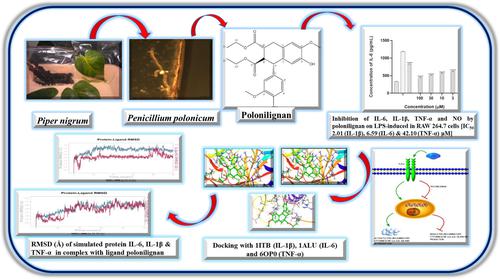当前位置:
X-MOL 学术
›
Chem. Bio. Drug Des.
›
论文详情
Our official English website, www.x-mol.net, welcomes your feedback! (Note: you will need to create a separate account there.)
Computational analysis followed by in vitro studies to explore cytokines (TNF‐α, IL‐6 and IL‐1β) inhibition potential of the new natural molecule polonilignan
Chemical Biology & Drug Design ( IF 3 ) Pub Date : 2024-03-07 , DOI: 10.1111/cbdd.14486 Pragya Paramita Pal 1 , P. S. Lakshmi Soukya 1 , Suraj Gupta 1 , Hiroshi Araya 2 , Yoshinori Fujimoto 2 , Ahil Sajeli Begum 1
Chemical Biology & Drug Design ( IF 3 ) Pub Date : 2024-03-07 , DOI: 10.1111/cbdd.14486 Pragya Paramita Pal 1 , P. S. Lakshmi Soukya 1 , Suraj Gupta 1 , Hiroshi Araya 2 , Yoshinori Fujimoto 2 , Ahil Sajeli Begum 1
Affiliation

|
Targeting pro‐inflammatory cytokines and their production is found to be of therapeutic benefit for the regulation of inflammation in various chronic autoimmune diseases. Our continued efforts to discover small molecular‐weight pro‐inflammatory cytokine inhibitors resulted in identifying a novel natural lignan molecule named polonilignan, isolated from the culture broth extract of an endophytic fungus Penicillium polonicum . An in silico study (molecular docking, ADME predictions, binding free energy calculation and molecular dynamics simulation) of the polonilignan over the pro‐inflammatory cytokines proteins TNF‐α, IL‐6 and IL‐1β was performed using Schrodinger LLC software to understand the binding interactions, drug‐like properties, and stability of the ligand‐protein complex. Further, in‐vitro testing of inhibition of TNF‐α, IL‐6 and IL‐1β by polonilignan was carried out using ELISA and RT‐PCR on LPS‐induced RAW 264.7 cell lines along with the testing of nitrite production effect (Griess assay) and cytotoxicity (MTT) analysis. Under the computational study, polonilignan revealed good docking scores, binding interactions, and stability under MDS and desirable in silico ADME results over the proteins TNF‐α, IL‐1β and IL‐6. Poloniligan showed significant inhibition of IL‐1β, IL‐6 and TNF‐α with IC50 values of 2.01 μM, 6.59 μM and 42.10 μM, respectively. Also, it reduced the translocation of the NF‐κ B subunit p65 to the nucleus (confocal microscopy). The mRNA expression levels of pro‐inflammatory markers IL‐1β, TNF‐α and IL‐6 levels were lowered significantly (p < .001) by the compound, and the diminution was higher with IL‐1β. Further, the lignan was non‐cytotoxic and effective in attenuating nitrite release (IC50 48.56 μM). Thus, polonilignan has been identified as a new pan‐cytokine and NO inhibitor, it is recommended to optimise a method for the synthesis of this small molecular weight lignan and explore its pharmacokinetic characteristics, toxicity and therapeutic effect under various chronic inflammatory disease models.
中文翻译:

计算分析和体外研究探索新型天然分子聚木脂素的细胞因子(TNF-α、IL-6 和 IL-1β)抑制潜力
研究发现,针对促炎细胞因子及其产生对于调节各种慢性自身免疫性疾病的炎症具有治疗作用。我们不断努力发现小分子量促炎细胞因子抑制剂,结果鉴定出一种新型天然木脂素分子,名为polonilignan,从内生真菌的培养液提取物中分离出来波罗青霉 。使用 Schrodinger LLC 软件对 polonilignan 对促炎细胞因子蛋白 TNF-α、IL-6 和 IL-1β 进行了计算机研究(分子对接、ADME 预测、结合自由能计算和分子动力学模拟),以了解配体-蛋白质复合物的结合相互作用、类药物特性和稳定性。此外,使用 ELISA 和 RT-PCR 对 LPS 诱导的 RAW 264.7 细胞系进行了多聚木脂素对 TNF-α、IL-6 和 IL-1β 抑制的体外测试,并测试了亚硝酸盐产生效果(Griess 试验) )和细胞毒性(MTT)分析。在计算研究中,polonilignan 显示出良好的对接分数、结合相互作用和 MDS 下的稳定性,以及相对于蛋白质 TNF-α、IL-1β 和 IL-6 的计算机 ADME 结果。Poloniligan 通过 IC 显着抑制 IL-1β、IL-6 和 TNF-α50 值分别为 2.01 μM、6.59 μM 和 42.10 μM。此外,它还减少了 NF-的易位。κ B 亚基 p65 至细胞核(共聚焦显微镜)。促炎标志物IL-1β、TNF-α和IL-6水平的mRNA表达水平显着降低(p < .001) 的化合物,并且 IL-1β 的减少程度更高。此外,木酚素无细胞毒性,可有效减少亚硝酸盐的释放(IC50 48.56μM)。因此,多木脂素已被确定为一种新型的全细胞因子和NO抑制剂,建议优化这种小分子量木脂素的合成方法,并探索其在各种慢性炎症疾病模型下的药代动力学特征、毒性和治疗效果。
更新日期:2024-03-07
中文翻译:

计算分析和体外研究探索新型天然分子聚木脂素的细胞因子(TNF-α、IL-6 和 IL-1β)抑制潜力
研究发现,针对促炎细胞因子及其产生对于调节各种慢性自身免疫性疾病的炎症具有治疗作用。我们不断努力发现小分子量促炎细胞因子抑制剂,结果鉴定出一种新型天然木脂素分子,名为polonilignan,从内生真菌的培养液提取物中分离出来



























 京公网安备 11010802027423号
京公网安备 11010802027423号